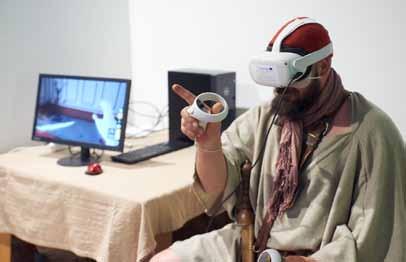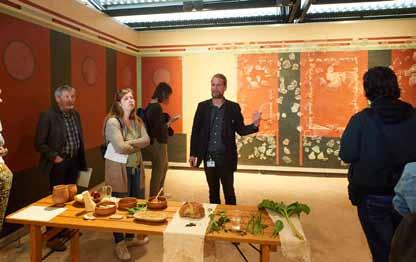
4 minute read
An area for visitors’ facilities development is available
ening existing and new communities. The routes show how different European countries and cultures can contribute to protecting and sharing our cultural heritage. All this helps to uncover Europe’s rich and diverse cultural heritage and develop networks of individuals, communities and places. The programs must bear in mind the aspects of responsible tourism, sustainable development and the protection of the living environment. Presentations about the Art Nouveau Routes in Europe and the Role of the Museum of Applied Arts in Budapest were given as examples of best practice. The next example focused on the EuroVelo, the European Cycle Route Network, which is an essential part of sustainable tourism trends. Three amazing stories about the Saint Martin of Tours Route, the Iron Age Danube Route and the ConnectIng hiSTorical Danube rEgions Roman routes project then followed. In sum, it can be said that the discussions should be continued, as it was made clear by the presentations that all the thematic routes face similar challenges. Cooperation could provide greater visibility to the initiatives and strengthen their ability to assert their interests.
Archaeology and Visualization powered by the Society of Archaeology and Art History
Advertisement
National mini conference Target group: International organisation; Education/training centre and school; Higher education and research; Local public authority; General public; SME The digitalization of archaeology was in the spotlight at this event. The event aimed to connect those experts from museums, universities and other cultural institutions who had also been working on the visualization of archaeological heritage and have an experience that is worth sharing in the premise of future collaboration. In the beginning and at end of the event guests had an opportunity to experience a VR exhibition in the Hungarian National Museum. This was introduced in a form of a presentation by experts from the Hungarian National Museum and Open Dimension Ltd, who made the visualization of the Vértesszőlős site. The participants heard different lectures, from the initial steps of the digitalization of the archaeological sites, to the latest museum presentations. The event showcased many good examples of how to present such content to the general public. The director of King Matthias Museum presented the visualization of the Visegrád palace step by step, including an interesting video of different types of visualizations of the site. Another good lecture was given by a group of archaeologists (Viktória Kiss, Szilvia Fábián, Dániel Gerber, Kitti Köhler, Ágnes Kustár, Balázs Gusztáv Mende, Anna Szécsényi-Nagy) about the facial reconstruction of a Bronze Age woman from Balatonkeresztúr, which was done based on the cranial structure of the woman. From the Budapest University of Technology and Economics, Zorán Vukoszávlyev and Máté Gergő Kovács talked about what kind of interpretation possibilities a Roman heritage site has in the 21st century. During this event we saw different possibilities for visualization, from facial reconstruction to landscape-scale modelling, as well as modelling for scientific purposes, or promotion for the public. In some cases, the visualization also helps further scientific research.
Virtual journey for kids
School program Target group: General public Museums play a very important role in informal education, but at the same time, they have found themselves in the even more difficult situation of having to make their exhibitions understandable for students, and thus for future adults. Learning “extensive chronologies” in schools requires the acquisition of a lot of factual information, but it cannot ignore the presentation of history from its beginnings, as otherwise the developmental processes of human societies become incomprehensible. With the result of D.T1.2.2 International working group forum evaluation and the draft of standards on archaeology in the school curricula, we planned to find the best solution to present the VR exhibition to students. After the opening ceremony of the VR room in Budapest, this school program was the first test event with a class of over 30 children. This event helped us to create a compact school program for kids that contains a museum pedagogical and VR tour in the archaeological exhibition. The intention is to plan smaller groups of up to 10 students and organize the tours in parallel to the real and VR exhibitions. The students also enjoyed watching their classmates’ adventures on the screens. It is recommended to explain the methods and the steps of the tours for the entire group first, and then repeat for individuals if necessary.
New routes, new opportunities - Heritage tourism in Hungary training school
Training school Target group: Education/training centre and school; Higher education and research The theme of the training school was archaeological thematic routes and heritage tourism in Hungary. As alternatives to cultural tourism, cultural routes enable a more thorough exploration of domestic regions and neighbouring areas. The purpose of the event was for university students to find the connection between archaeological and natural treasures points. The main question of the workshop was how the archaeological sites can be shown in accordance with today’s expectations to the general public. Focusing on different visitor groups and side programs, it was presented with modern devices, and offered different tours in length and depth. The first part of the workshop was an introduction section via short lectures on branding and connecting heritage sites with tourism through promoting hiking trails, and intertwining them with other leisure activities to take time to explore local history and culture, while also supporting the environment. Heritage protection specialists (the Association of Cultural Heritage Managers, Hungarian Hikers Association and Hungarian National Museum) also presented at the school, focusing on current challenges and offering best practices as solutions. As the second part of the programme, four teams were formed under the guidance of two instructors with expertise in the topics. The four groups








